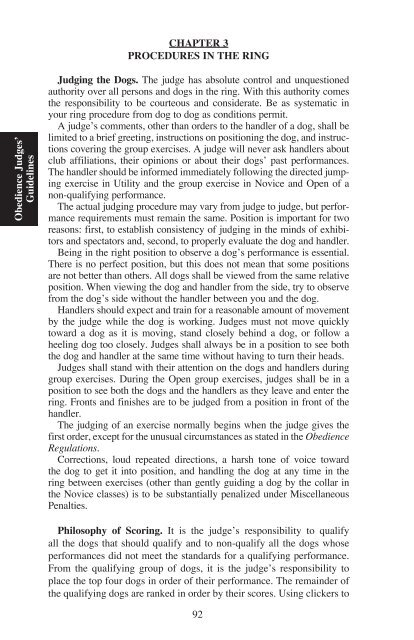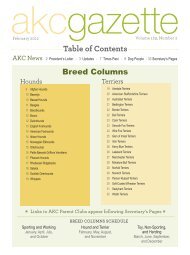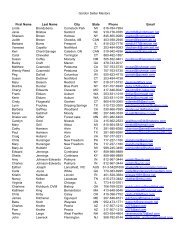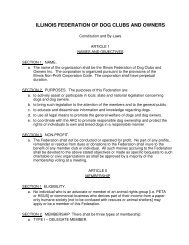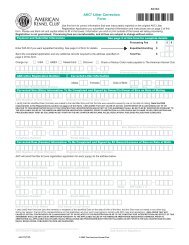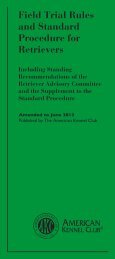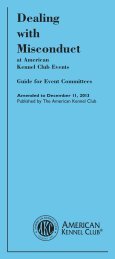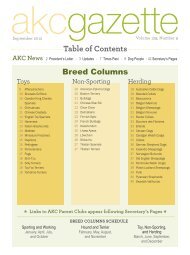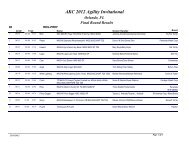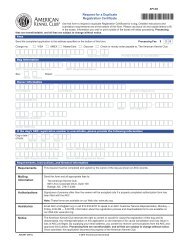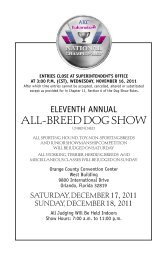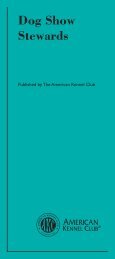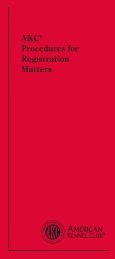Obedience Regulations - American Kennel Club
Obedience Regulations - American Kennel Club
Obedience Regulations - American Kennel Club
You also want an ePaper? Increase the reach of your titles
YUMPU automatically turns print PDFs into web optimized ePapers that Google loves.
<strong>Obedience</strong> Judges’<br />
Guidelines<br />
CHAPTER 3<br />
PROCEDURES IN THE RING<br />
Judging the Dogs. the judge has absolute control and unquestioned<br />
authority over all persons and dogs in the ring. With this authority comes<br />
the responsibility to be courteous and considerate. be as systematic in<br />
your ring procedure from dog to dog as conditions permit.<br />
A judge’s comments, other than orders to the handler of a dog, shall be<br />
limited to a brief greeting, instructions on positioning the dog, and instructions<br />
covering the group exercises. A judge will never ask handlers about<br />
club affiliations, their opinions or about their dogs’ past performances.<br />
the handler should be informed immediately following the directed jumping<br />
exercise in utility and the group exercise in novice and open of a<br />
non-qualifying performance.<br />
the actual judging procedure may vary from judge to judge, but performance<br />
requirements must remain the same. Position is important for two<br />
reasons: first, to establish consistency of judging in the minds of exhibitors<br />
and spectators and, second, to properly evaluate the dog and handler.<br />
being in the right position to observe a dog’s performance is essential.<br />
there is no perfect position, but this does not mean that some positions<br />
are not better than others. All dogs shall be viewed from the same relative<br />
position. When viewing the dog and handler from the side, try to observe<br />
from the dog’s side without the handler between you and the dog.<br />
Handlers should expect and train for a reasonable amount of movement<br />
by the judge while the dog is working. Judges must not move quickly<br />
toward a dog as it is moving, stand closely behind a dog, or follow a<br />
heeling dog too closely. Judges shall always be in a position to see both<br />
the dog and handler at the same time without having to turn their heads.<br />
Judges shall stand with their attention on the dogs and handlers during<br />
group exercises. During the open group exercises, judges shall be in a<br />
position to see both the dogs and the handlers as they leave and enter the<br />
ring. Fronts and finishes are to be judged from a position in front of the<br />
handler.<br />
the judging of an exercise normally begins when the judge gives the<br />
first order, except for the unusual circumstances as stated in the <strong>Obedience</strong><br />
<strong>Regulations</strong>.<br />
corrections, loud repeated directions, a harsh tone of voice toward<br />
the dog to get it into position, and handling the dog at any time in the<br />
ring between exercises (other than gently guiding a dog by the collar in<br />
the novice classes) is to be substantially penalized under miscellaneous<br />
Penalties.<br />
Philosophy of Scoring. it is the judge’s responsibility to qualify<br />
all the dogs that should qualify and to non-qualify all the dogs whose<br />
performances did not meet the standards for a qualifying performance.<br />
From the qualifying group of dogs, it is the judge’s responsibility to<br />
place the top four dogs in order of their performance. the remainder of<br />
the qualifying dogs are ranked in order by their scores. using clickers to<br />
92


